What is Airstream Mechanism or Respiratory Process
Respiratory Process
As it is already known, the respiratory process is one of the four main stages of speech production. In this article, the thorough concept and complete working of the ‘airstream mechanism’ is explained. Before moving forward, first, it is important to know about how the respiratory system works with respect to airflow which creates speech sounds.
The respiratory process provides potential and necessary organs for speaking. This tract begins at the mouth and nose openings and ends within the lungs. One part of the respiratory tract is the upper respiratory tract, which is formed by the nasal cavity, oral cavity, pharynx, and larynx. The other lower part of this tract is composed of the trachea, two bronchi, and the lungs.


The lower respiratory tract mainly functions for respiration for speech production (elevation of ribs). The lungs are situated inside the bony rib cage. They are made of elastic, non-muscular tissues which are surrounded by the alveoli or air. They oxygenate blood and provide the energy source for the airflow. The lungs stretch when the rib cage and diaphragm move, drawing air into the lungs or pushing the air out when they are compressed. Further, the amount of air inside the lungs controls the pressure of the airflow.


The contracted muscles in the chest are used to breathe as well as to produce the required airflow to produce sounds. However, speech breathing is different as compared to ordinary breathing. While speaking, a much amount of air is exhaled through the narrow opening of the glottis, and then a controlled amount of air is inhaled. Actually, it is all and all depends on the control of the structures and muscles which help in breathing for speaking.
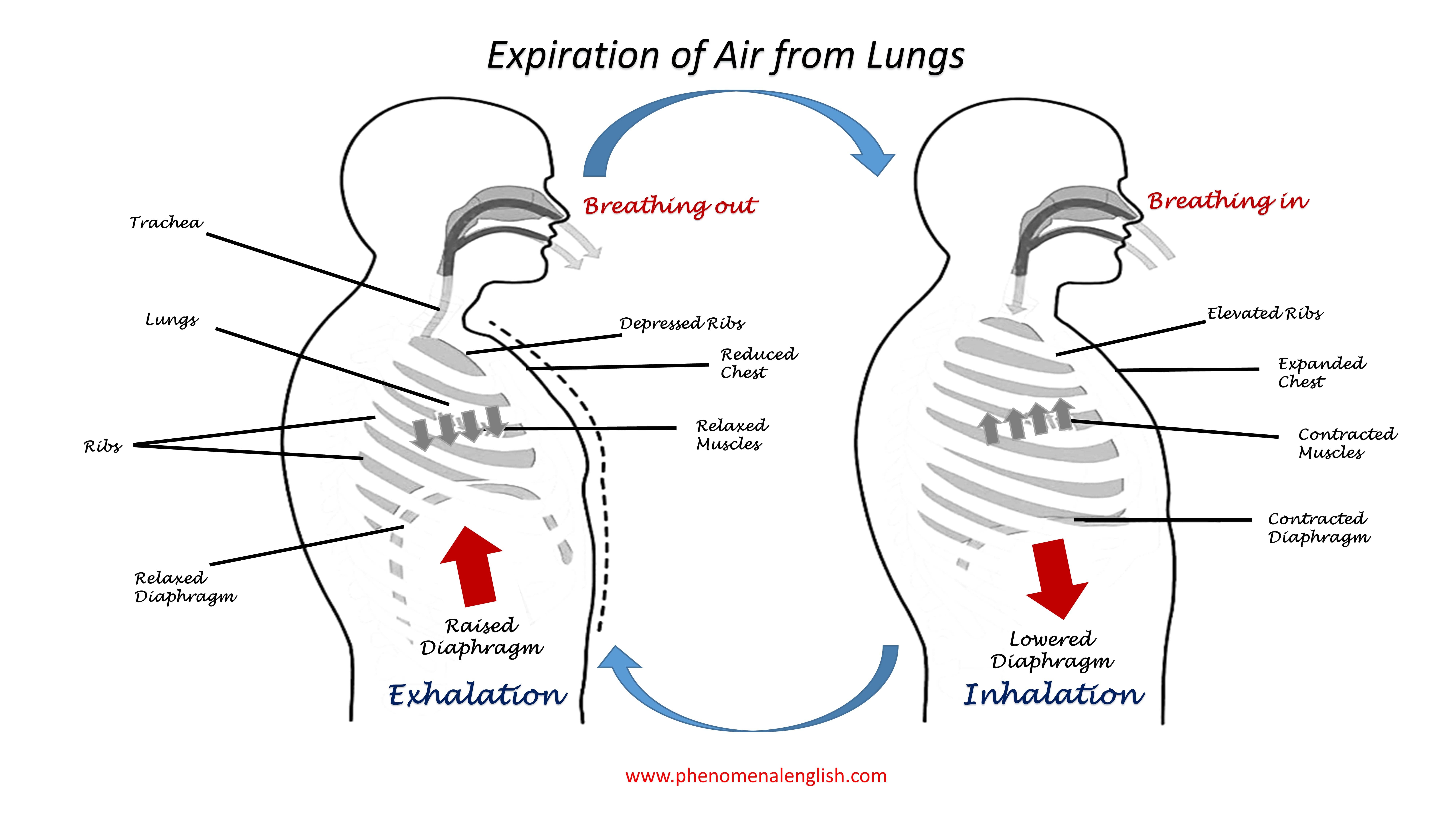

In general, air gets into the lungs through the passage of the nose, pharynx, larynx, trachea, and bronchi after that it gets out from the lungs through the passage of the windpipe and enters the larynx or voice box where many different modifications occur, and then passes through the mouth and nostrils and at last different speech sounds are produced.
Airstream Mechanism
The word ‘airstream’ means ‘current of air’, specifically ‘the airflow’. It ascribes to the process by which the vocal tract creates airflow along with phonation and articulation. Owing to this phase, the production of the speech sounds starts. The organ that generates the airstream is called the initiator and sets up the first part of the production of airflow, called initiation. There are three initiators, the diaphragm, the glottis, and the tongue that perform their function by decreasing or increasing the pressure in the air, and these organs are used to generate airstream. The direction of the movement of an initiator creates the following two types of pressure:
- Positive Pressure --- Egressive (Outgoing)
- Negative Pressure --- Ingressive (Incoming)
So, the air is said to be ‘egressive’ or ‘outgoing’ when the air goes ‘outwards’ which means the air pressure inside the mouth is greater than the air pressure outside the mouth. On the contrary, the air is said to be ‘ingressive’ or ‘incoming’ when the air goes ‘downwards’ which means the air pressure inside the mouth is lower than the air pressure outside the mouth. However, speech sounds are produced with one of three airstream mechanisms, or uncommonly with a combination of two of them. These three airstream mechanisms are:


1. Pulmonic Airstream Mechanism: (Laryngeal Mechanism)
The airstream which proceeds in the walls of the lungs is called a pulmonic airstream. It refers to the movement of lung air (actually the diaphragm and ribs) by the respiratory muscles. Not only in the English language but also in other languages, a number of sounds are made by the contraction of the diaphragm muscles in which air is pushed out of the lungs and expelled through either the mouth or the nose. In fact, all human languages employ these types of sound i.e vowels.
Pulmonic Egressive Sounds (Plosives):
Such sounds, in which the air from the lungs is driven out while speaking, are called plosives. The only airstream mechanism that uses lung air and this movement describes an outgoing airstream.


Pulmonic egressive sounds have the following facts:
- Airflow is pointed outwards towards the oral cavity.
- This airstream mechanism produces all English sounds (both consonants and vowels).
- Compression of lungs builds pressure and produces sounds like [p], [n], [s], [I], [e]
- According to aspiration (the sound is followed by a puff of air when vocal folds are loosed after the sound by the speaker) Speech is classified into two ways:
- Aspirated (puff of air) ph, th, kh
- Unaspirated (no puff of air) p t k
The given sequence must be followed to produce a pulmonic egressive airstream.
Pulmonic Ingressive Sounds:
Pulmonic ingressive sounds are produced by reforming inhaled air or by forcing the air pressure to flow into the lungs. This is only found in a few rare and special cases, such as in Tsou
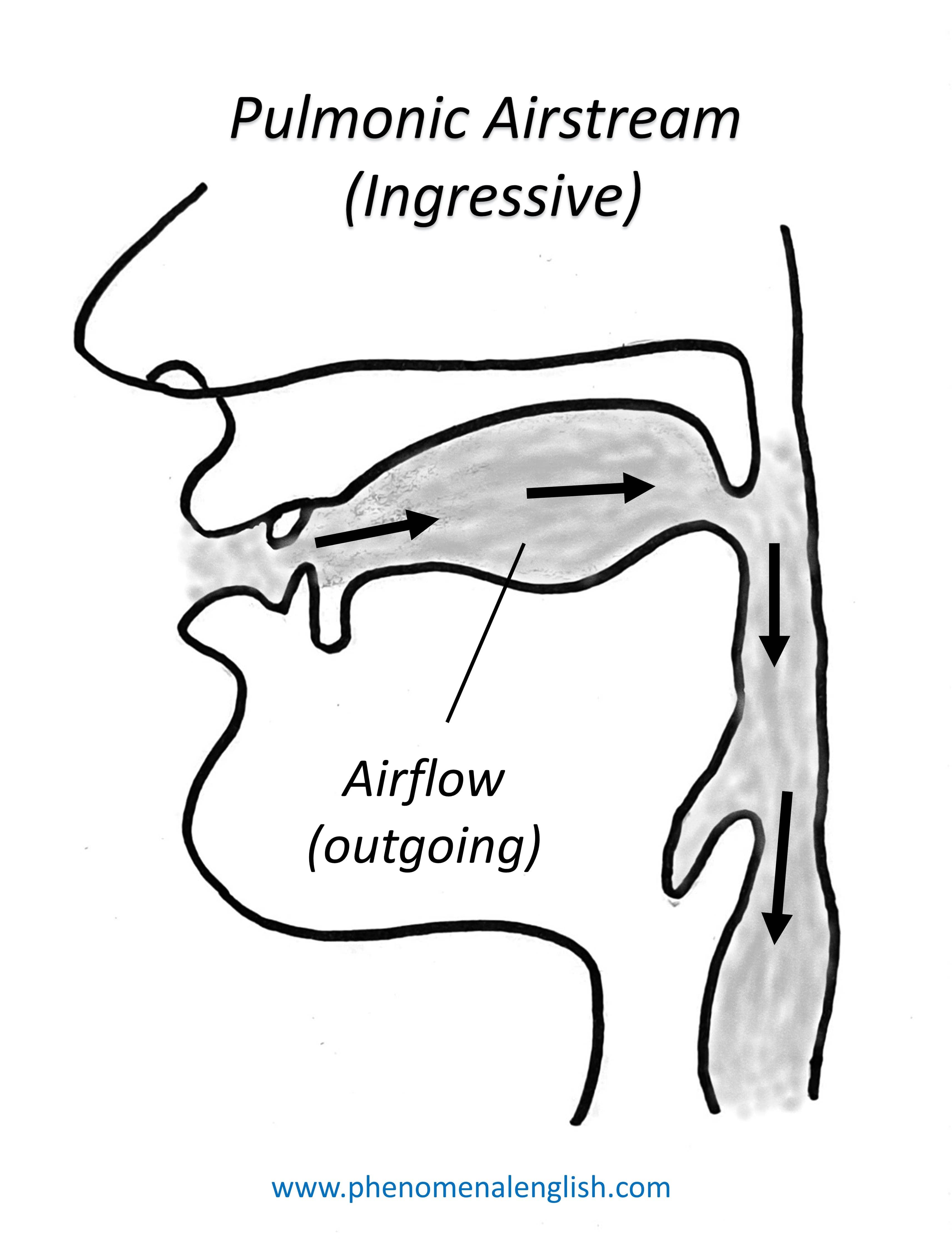

Pulmonic ingressive sounds have the following facts:
- Airflow is pointed inwards from the oral cavity into the lungs.
- This sound is like the sound of a gasp that is created in a surprised mood.
- In interjections, pulmonic ingressive vowels or words occur on all continents but not in normal words.
2. Glottalic Airstream Mechanism: (Pharyngeal Mechanism)
It is possible that the airstream initiates airflow in the upper vocal tract with the use of the glottis or vocal cords, which is known as a glottalic airstream. The action of the glottis refers to the movement of air in pharynx. Here, a sound is produced by an upward movement of the closed glottis pushes the air out of the mouth whereas a downward movement of the closed glottis causes air to be sucked into the mouth.
Glottalic Egressive Sounds (Ejectives):
Such sounds, in which the air column is compressed as the glottis moves upward, are called ejectives. Ejective and ejective-like consonants occur in 16% of the world’s languages.
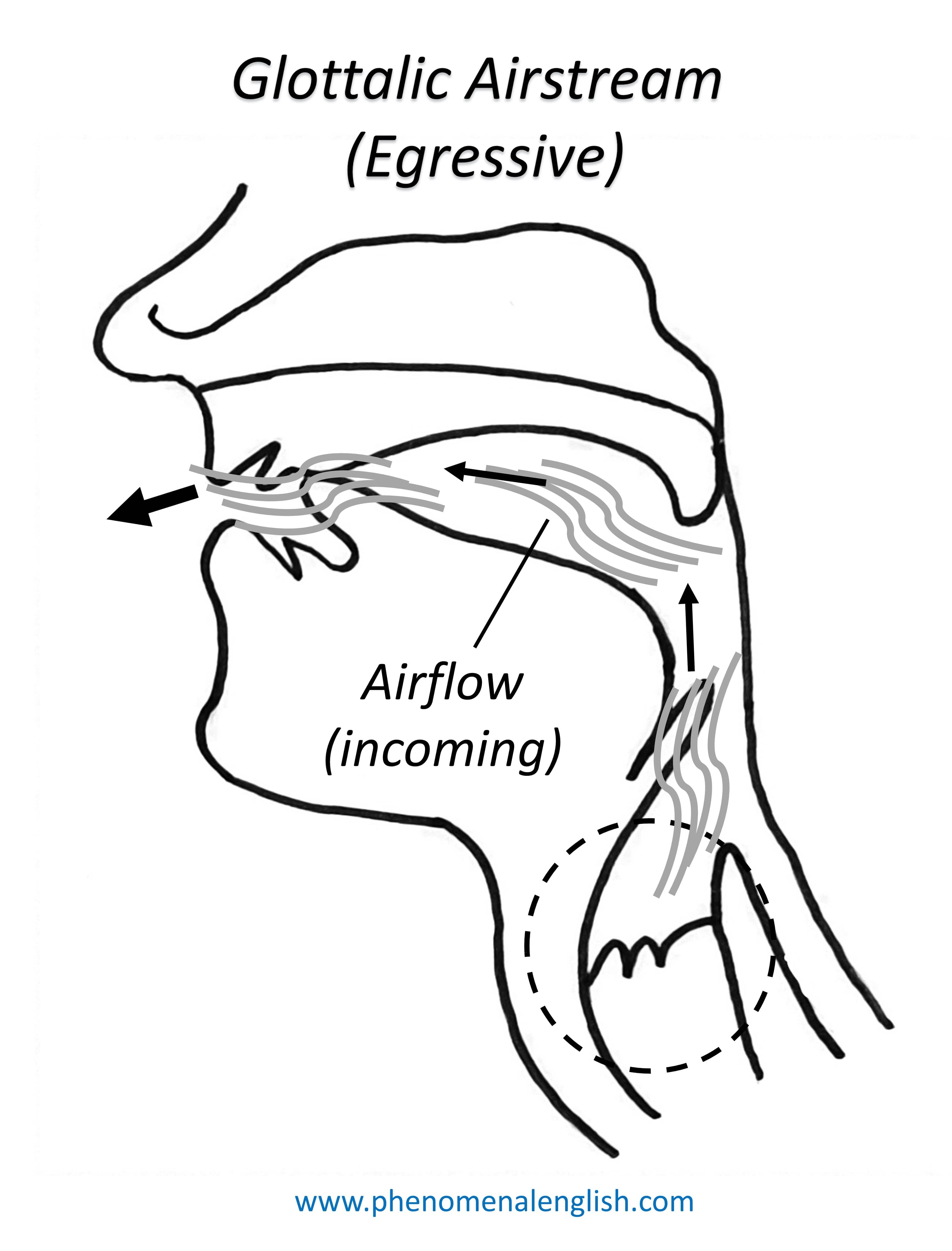

Glottalic Egressive sounds have the following facts:
- Airflow is pointed outwards towards the oral/nasal cavity.
- To form ejectives, the glottis must be fully closed as the air column would flow backward over it.
- Pushing up closed glottis builds pressure and produces Georgian sounds [p'], [t'], [k']
Glottalic Ingressive Sounds (Implosives):
Such sounds, in which the air is compressed as the glottis moves downward, are called implosives. Ejective and implosive-like consonants occur in 13% of the world’s languages.
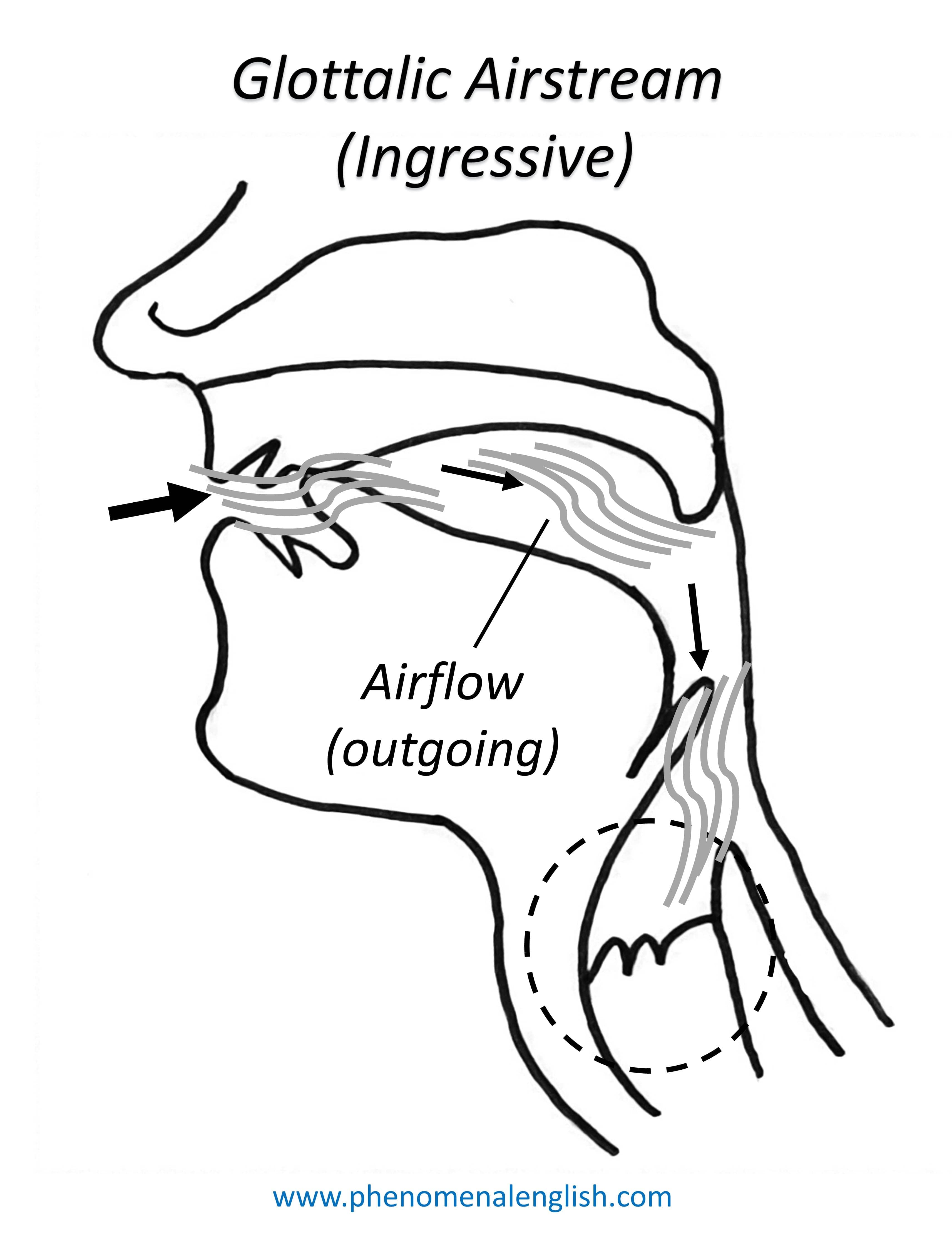

Glottalic Egressive sounds have the following facts:
- Airflow is pointed inwards from the oral cavity.
- To form implosives, the glottis is not necessary to close fully as the air column would flow forwards over the descending glottis.
- Pulling down closed glottis reduces pressure and produces Hausa, Sindhi [b,g]
3. Velaric Airstream Mechanism: (Lingual Airstream)
The airstream which is formed by the movement of the body of the tongue in the oral cavity, is called a velaric airstream. It refers to the movement of mouth air by the action of the tongue. There is a velar closure formed by raising the back of the tongue when using this airstream. Here, a sound is produced by a closure at two places of articulation and the back of the tongue seals off air from the lungs and makes a relative vacuum. Moreover, this airstream brings up to the movement of the air in the mouth by the tongue to produce different speech sounds.
Velaric Egressive Sounds:
Velaric Egressive sounds can be only produced by the front and back of the tongue or lips and back of the tongue which must seal off the vocal cavity and the cheeks and middle of the tongue must move inward and upward to escalate oral pressure. These conditions are not possible physically because there is no way to compress the part of the oral tract between the velar closure and the former closure.
Velaric Ingressive Sounds (Clicks):
Such sounds, in which the air is enclosed in the oral cavity by lowering the tongue and then the air is released at places of articulation, are called clicks. Clicks as regular speech sounds are found in Southern African languages and are implied as interjections in other languages.
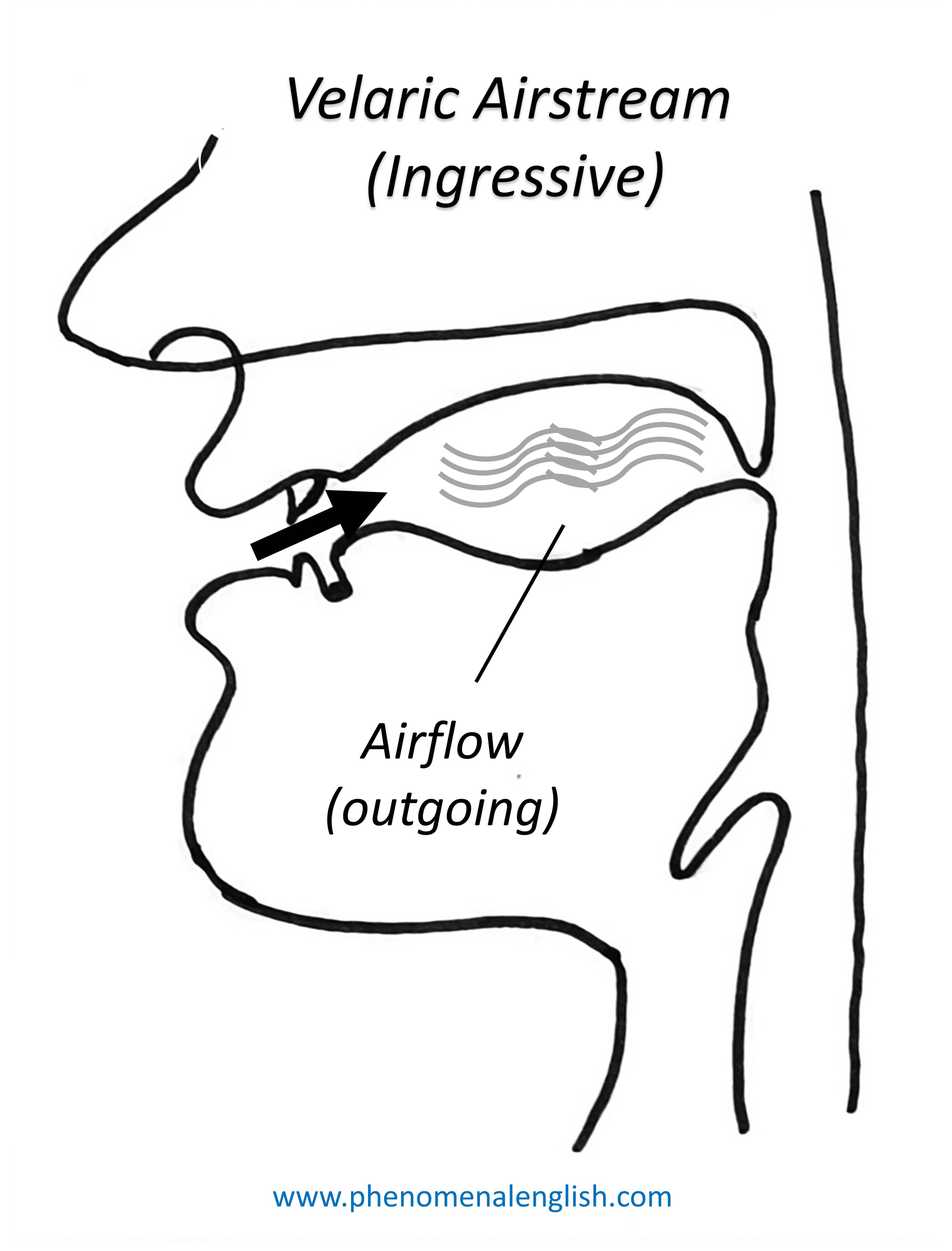

Velaric Ingressive sounds have the following facts:
- Airflow is pointed inwards from the oral cavity.
- Clicks sounds are suction sounds made in the mouth.
- In interjections, pulmonic ingressive vowels or words occur on all continents but not in normal words.
- Pulling down the tongue and velaric and alveolar closure reduces pressure and produces clicks [kissing, gee up].
In order to wind up the concept of the airstream mechanism, a quick review or a summary of all airstream mechanisms is given in the form of a table below:
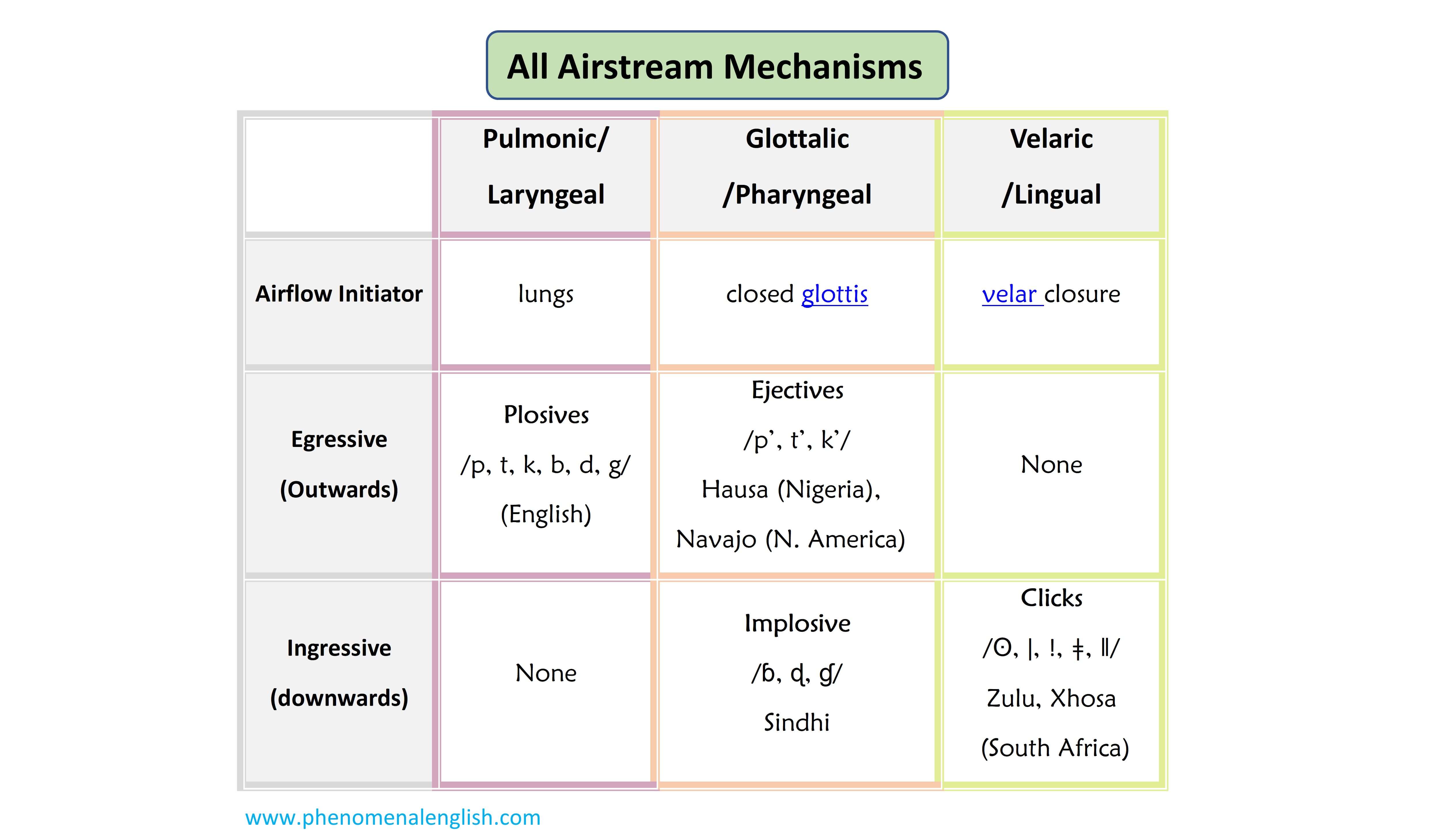

In the end, the airstream mechanism refers to the investigation of how sounds are produced will begin with the vocal tract and the means of initiating airflow by creating pressure in the vocal tract. The differentiation of the types of airstream mechanisms by the organ depends upon the initiator where the air is initiated which is Egressive and ingressive. In addition, normally, speech sounds are produced with air that stems from the lungs, proceeds through the windpipe (trachea), and passes through the mouth.
Irritating Concepts of Grammar
- Why we don't add s or es in verbs with singular subjects in Present Indefinite Tense
- Why we use HAVE with I despite I is a singular subject
- What is difference between He-She and That, It and This, These-Those and They
- Strong and weak verbs
- Finite and non-finite verbs
- What is Meter in poetry and how to find Meter of a Poem